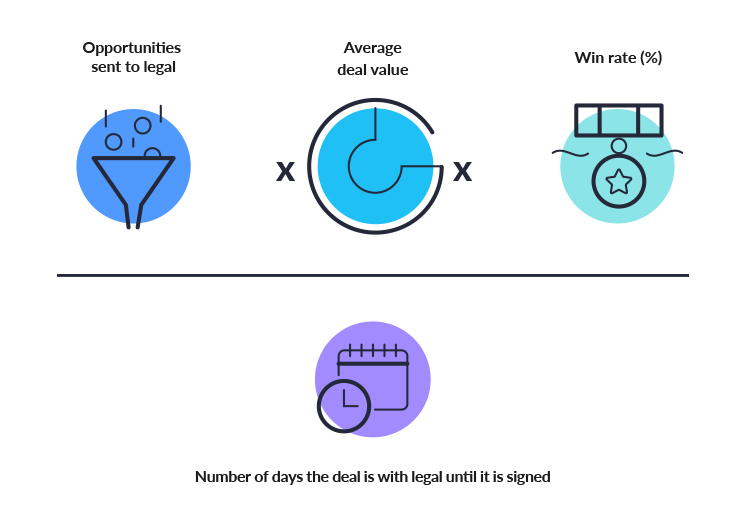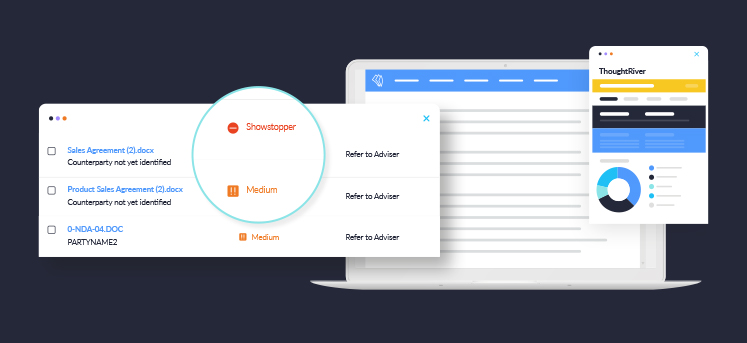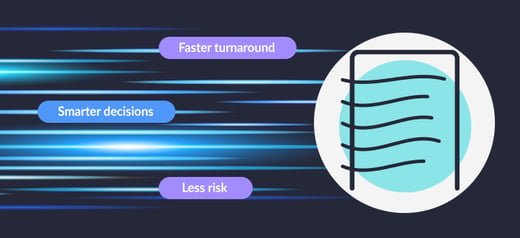Discover the formula for measuring deal velocity, learn how it can be improved, and how to ensure sales, procurement and legal are always aligned.
Helping legal to move at the pace of business
As the old saying goes, there are two sides to any business transaction. However, we are not talking about a buyer and a seller in this blog article. Instead we are referring to the person or persons negotiating the deal – whether they work in sales as vendors, or in procurement as buyers – and the legal team responsible for formalising the transaction at the contracting stage.
This is because the process of moving from the commercial negotiation to the contract drafting, terms negotiation, and final signature is often disjointed and misaligned. Traditionally, legal professionals have perhaps been overworked and maybe even inadequately incentivised to align themselves with the need for speed felt elsewhere in the business. The urgency and hunger on show during sales negotiations can sometimes come to a crunching halt, to be replaced by the methodical precision and risk management of the legal team. It can be related to racing down a motorway in top gear, only to hit a restricted speed limit with reduced width lanes, and have to apply the brakes and drive much more carefully. All being well, you will still arrive at your destination, albeit more delayed than you would have liked. Worst case scenario: plans are changed due to the delay, and all that effort has gone to waste.
Legal teams want to help businesses accelerate, in fact they want to be that accelerant, and we will explore how the deal velocity metric can help make that dream a reality while still allowing them to manage risk appropriately.
A focus on deal velocity
Deal velocity is the speed with which a company negotiates and then signs a contract to close a transaction. This final mile is always the most important of any deal, but almost always the least optimised for speed.
A deal cycle begins when a client or supplier has verbally agreed a deal with your sales or procurement department, at which point a contract to enshrine that deal is drafted. What happens next is crucial: a typical commercial negotiation takes between five and 10 iterations or turns of that contract to get to an agreement, with each iteration taking typically a few days, or sometimes weeks. This process happens because the lawyers want to discuss and negotiate the specific language to encapsulate what has been agreed commercially while also managing their companies risk exposure.
Every day wasted at this stage is an unnecessary drag on your cash flow and also additional risk. It can even imperil the deal: if the contract negotiation process stalls, the client is more likely to change their mind or listen to rivals or get disrupted by a global pandemic. The negotiation period should be your best opportunity for impressing the client and really cementing the relationship – not driving them away out of frustration.
How is deal velocity different to sales velocity?
Sales velocity is how efficient you are at getting from initial contact with a prospect or lead to signing a deal with them to make them a customer. It covers all of the time and effort from opportunity created to opportunity closed.
Deal velocity is a subset of that measurement. The deal cycle starts when sales or procurement have verbally agreed a deal with a client or supplier and at that point a contract is drafted and the lawyers really get to work. This is when the deal velocity clock starts ticking. The clock stops once the contract is signed.
Deal velocity is how quickly you get from draft contract to signed contract, and can also be shown and measured as a simple metric. This is a very important metric to focus on because as an opportunity moves through the various stages towards a signature, the more important and valuable it becomes. When it has reached the legal team, most organisations would be forecasting the deal at around 75% likely to close; therefore any deals lost at this stage are more painful than ever. The problem for sales leaders at this point is that as the value and importance of the deal is increasing for them, their control of the deal starts to diminish as the legal team takes on the dialogue. Deal velocity is the metric that aligns these teams and turbocharges your business.
Jennifer Hill at Remedy Analytics measures her deal cycle from contract to signature, and we think you should be like Jennifer and do the same. Your key data points are:
- Number of opportunities that reach the draft contract stage
- Average deal size
- Win rate/Conversion rate from draft contract to signed contract
- Deal cycle – the number of days spent on average from draft contract to signed contract
These data points are then used as shown below to calculate deal velocity.

A deal velocity example
Chudleigh & Co. usually has five deals progressing through legal per month with an average deal size of $100k. Once a deal reaches legal they have a win rate of 75%. Typically, these deals spend a month in legal before they get signed.
5 x $100,000 x 75% = $375,000 / 30 = $12,500
If Chudleigh & Co. can reduce their 30-day deal cycle to 21 days by using an automated contract review tool then they will increase their deal velocity to $17,857.
A shared metric that can be measured and improved
The critical element of deal velocity is that you can use this formula to measure and monitor performance of your business, by really caring about the efficiency of your dealmaking. And if it can be measured, then it stands to reason that it can also be improved.
In doing so, deal velocity should be positioned as a strategic and aligned goal across functions. Ownership does not sit solely with legal: it is a metric that can be shared through sales, procurement, and cared about by all business leaders.
For example, increasing the number of opportunities that are sent to legal or their average deal size will increase deal velocity. Likewise a higher win rate percentage, or a faster contract negotiation time, will also boost this figure. In this way, it is not legal’s sole responsibility to drive deal velocity. Everyone has to play their part, and the formula will clearly illustrate how each function is either increasing or decreasing deal velocity at any given time.
Empowering legal to boost deal velocity
Using a contract acceleration platform (CAP) like ThoughtRiver to improve the speed and accuracy of the contracting process transforms the legal department from a bottleneck to a frictionless enabler of velocity. It means that legal can help sales or procurement to get a first pass review of their new contracts within minutes. Who would say no to that?

Conservatively, assuming your sales team could remove two days from their deal cycle per contract iteration by using an AI contract pre-screening tool (part of our CAP), in a typical transaction, that could translate to as much as 10-20 days shaved off of the deal cycle. Most of our customers tell us that they see speed improvements of between one third and two thirds in terms of their contract review time. Any salesperson or business leader who has missed quota because a deal landed a few days late, or lost a deal due to a changing environment, will understand the importance of pulling signatures and therefore revenues forward. Every lawyer who has been working until midnight to finalise the deal that the CEO is watching will understand the pain of all deals going down to the wire. Every day makes a huge difference!
Contract acceleration and contract review technology like this enables sales to close deals faster, and move on to finalising the next negotiation; so not only does it speed up deals, but it also allows more deals to happen. Likewise, procurement can turn savings on paper into financial benefits that are actually realised by the organisation and shown on the bottom line.

More than that, it provides transparency into the contracting process itself, an area that has traditionally been something of a murky black hole for those outside of legal. With the company’s contracting policies and playbook enshrined on the ThoughtRiver platform, sales and procurement could even start to self-serve. They could quickly understand which clauses are or are not acceptable, and have access to their legal teams’ approved wording as suggestions as a replacement for any risky language. With ThoughtRiver, all of this is provided within MS Word and so feels completely natural to the user.
Learn how you can improve your deal velocity
Deal velocity is not something to retrospectively apply to finalised deals for reporting purposes. It is a metric that can be analysed to identify improvements and allow businesses to take the necessary steps to proactively increase deal velocity. Contract acceleration technology is central to enabling legal to operate with the speed and accuracy that maximises the value of each and every transaction.
Download the deal velocity playbook to learn more and get the full picture. Get the playbook >




